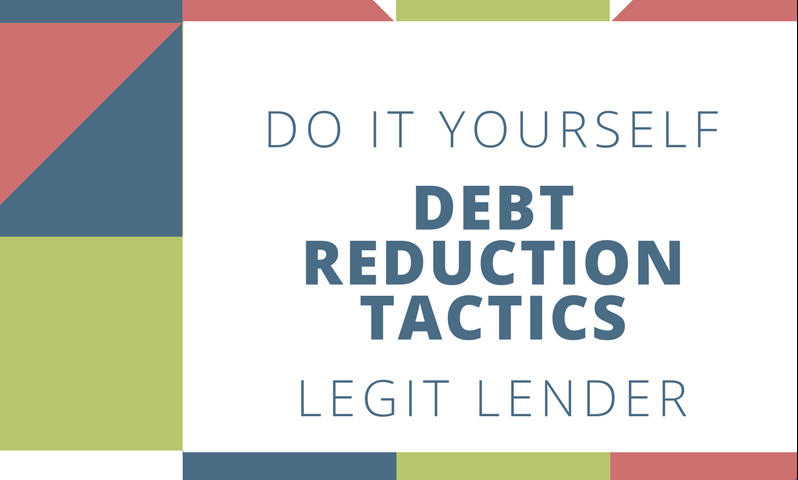
UPDATE: Kayla at Reviews.com has compiled a nice list of lenders offering debt consolidation loans. Check it out!
Nobody intends to get in over their head in debt, but sometimes life has a way of overwhelming and taking us by surprise. This can especially happen with credit cards since it is so easy to run up credit card debt without even realizing it. When you can no longer even make the minimum payments and worse, when collectors start calling, your first reaction is likely to just run away or bury your head in the sand. Debt reduction seems impossible.
Although a ‘flight’ reaction is understandable and even natural, it is one of the worst things you can do. Ignoring your debts will leave your credit in shambles for years to come. And don’t think that this will just affect your ability to get another loan. Fair or not, your credit score and credit history is used by prospective landlords, insurance agents and potential employers to evaluate how responsible you are as an individual.
There are responsible ways to reduce your debt load that will have a much less negative impact on your credit and your finances than just running from your debt. And while there are professional services that can help you with debt reduction, there are several strategies that you can first attempt to settle credit card debt on your own.
First Things First: Stop Taking on New Debt

Picking up new debt as you pay off old debt gets you nowhere. So if you are serious about reducing your debt, you first need to commit to not taking on new debt, lest you find yourself once again neck deep in debt a few months down the road. This means no longer spending with credit cards, not financing cars and certainly no payday loans. Unless you make this commitment, your debt reduction strategies will just be spinning wheels in mud.
Negotiate Directly With Credit Card Companies

Credit card companies aren’t going to cut you a break out of sheer kindness. However, there’s a good chance that they’ll cut you a break out of self-interest. They want to avoid you defaulting just as much as you do. If you default on your debt, they typically write it off as a loss and sell it to collection agencies for pennies on the dollar. This is a lose-lose for you and the party you owed money to.
To avoid the hassle of dealing with you defaulting, lenders will often offer debt repayment plans with more favorable terms than your current debt. They may forgive a portion of your debt, may roll it into a lower interest loan. Either way, they will most likely leave you with a more manageable monthly payment.
Kyle, blogger at Steward and Slave, was drowning in credit card debt but was able to work with Discover to roll almost $10,000 of credit card debt with a 21% interest rate into a personal loan with only a 10% interest rate. However, Kyle is quick to note that such restructuring opens the door to simply running up more high interest credit card debt.
Balance Transfer For a Lower APR
Part of what makes credit card debt so hard to handle is the high interest rates that typically come with credit cards. If you have multiple cards, identify the cards with the lowest rates and transfer as much as possible from the higher rate cards to the lower rate cards.
If your credit is still intact (meaning you haven’t missed any payments yet and aren’t overdrawn on accounts), you may even be able to qualify for a new credit card with a 0% introductory APR.
One thing to be aware of, however, is balance transfer fees. Although they differ from card to card, there is usually a fee to transfer credit card balances. If the amount you’ll save in interest charges exceeds any fees you’ll be charged, a balance transfer makes sense. However, if the interest savings is negligible, you’re probably better off skipping this strategy.
DIY Debt Consolidation
Similar to transferring your credit card balance to another card with a lower rate, debt consolidation transfers all your high interest debt to a single loan with a lower interest rate. Debt consolidation also simplifies your finances by reducing the number of payments you have to make. Typically, debt consolidation is a service offered by third party lenders. But, you may be able to do your own debt consolidation.
Although not everyone will be able to do their own debt consolidation, if you own a home, you may qualify for a home equity loan. Because lenders use your home as collateral, they can offer you a loan at significantly lower interest rates than your credit card debt. By taking out a home loan and using the money to pay off your credit card balances, you eliminate your higher interest debt in exchange for a single payment on a low interest loan.
Buckle Down and Pay Down

Regardless of your success, you may still be left with some debt. Completely eliminating your credit card debt and other debt simply requires doing the hard work of steadily paying it down, month after month. To speed up this process, look for areas where you can spend less, so you can divert more of your income towards eliminating your debt.
As you find more money to put towards paying off your debt, you may decide to first focus on knocking out your smaller balances, also known as the snowball method, or you may want to plow all your extra payments towards your highest interest debt, known as the avalanche method. Figure out which one works best for you psychologically and stick with it. At the end of the day, the important thing is that you stay motivated to dig yourself out of your debt pile.